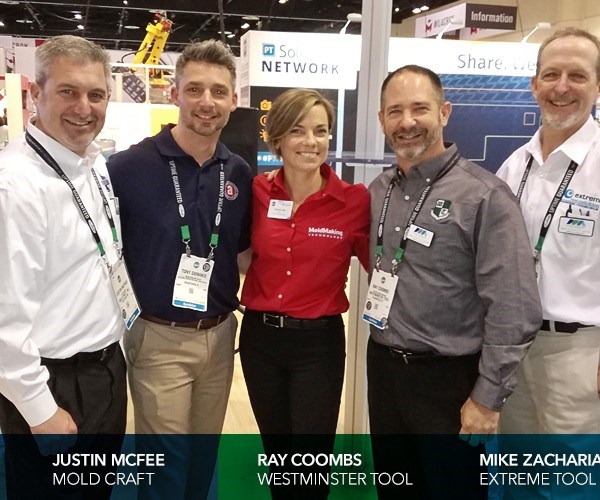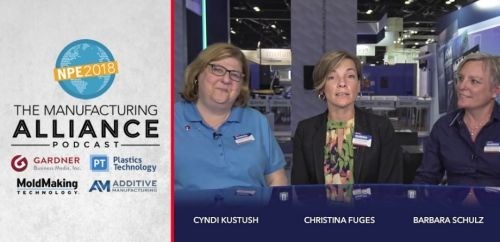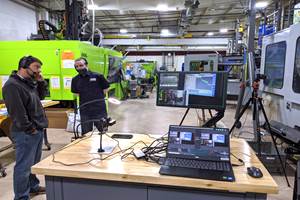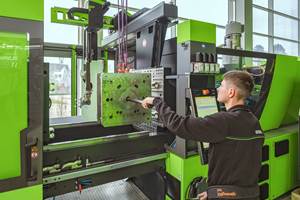Moldmaking on Full Display at NPE2018
Collaboration is the name of the game, as more than 60 North American mold builders showcased their capabilities in shared demonstrations across the show floor.
Share
Collaboration was the key takeaway from NPE2018 for the MoldMaking Technology (MMT) team. Mold builders did not confine themselves to the traditional role of working solely at their booths. Instead, they partnered with other companies in multiple booths to showcase their wares.
The MMT team counted more than 60 North American mold builders who exhibited, and that is a big number compared to NPE2015. Collaboration was everywhere on the show floor among mold builders, molders and molding machine manufacturers who demonstrated molds, tooling, hot runners, mold components and processes. Here is just a sampling:
Mold Craft brought micro molding to NPE2018, where molded two variations of a 100-micron filter screenit. The Mold Craft booth ran a two-cavity micro mold using POK resin in a Battenfeld Wittmann MicroPower 15-ton press, and the Sodick Plustech booth ran an eight-cavity micro mold using PPSU (solvay polyphenylsulfone). Both molds had 0.004-inch by 0.004-inch shutoffs (100 micron) and 0.013-inch and 0.008-inch wall sections with a part weight of less than 0.007 grams in POK and 0.0095 grams in PPSU. Mold Craft managed both R&D projects from the part design to mold-cavity design and finally processing. The shop also introduced its Production Quality Prototype (PQP) product offering that provides engineering-quality sample parts in a prototype micro mold and provides proof of concept for customers developing a new part intended to run in a micro mold. This is a parts-to-print process for projects using any engineering resin.
M.R. Mold was one participant in a collaborative demonstration that produced a headlamp optic. IndustriesZeiger molded an automotive LED headlamp optic made from Dow's Dowsil MS-4007 moldable silicone on a Milacron-FANUC Roboshot a-S55iA with its new iHMI Controller. Zeiger's Plug-n-Play Conversion Kit incorporated a Wexco 777 water-cooled barrel, a Zpringlok LSR pre-closed check-ring valve, a ZSAR PM zero-compression ratio screw, liquid silicone rubber (LSR) screw and proprietary barrel and screw sealing device. M.R. Mold's two-cavity, LSR, fully automatic mold, which incorporated a single-drop cold runner system, ran in the production cell comprising an ELMET TOP 5000P dosing system and a Thermal Care air-cooled EQ3A01 portable chiller. A YushinYC-100S-11-8 robot with an E-Touch Compact controller, a custom engineered end-of-arm tool and a Yushin indexing conveyor enabled the cell to run fully automatic. Sigmasoftprovided a virtual molding simulation of the filling and curing process..
M.R. Mold also partnered with R.D. Abbott Co., a full-service elastomers supplier, which showcased a Liquid Additive Manufacturing (LAM) 3D printer in the booth. R.D. Abbott Co. developed this LAM 3D printer in collaboration with German RepRap GmbH and Dow Silicones. German RepRap’s LAM platform combined with Dow’s 3D Printable EVOLV3D LC 3335 LSR is potentially capable of printing functional prototypes and enables small manufacturing trials of complex parts. Also, the material’s properties closely match those of molded LSR, facilitating an easy transfer into injection-molding processes for high-volume manufacturing.
Mold builders strive to achieve 100-percent straight parts on any mold build, but the many dynamic process variables make this a challenge. For example, most people in the mold building arena try to mold pipette syringes, or deep-draw parts, with a single side gate. However, this puts stress on the core pin, which causes deflection. Others use unconventional methods to fine-tune the mold to produce parts to specification, but this may require stressing the core steel in a way that causes premature wear to the molding components. Basically, unless a mold builder uses a perfectly balanced hot runner system, the process will not yield 100-percent straight parts.
Cavaform decided to take on the challenge of developing a better solution. Its engineering team developed a double side-gated hot runner concept using a balanced manifold that fills each part through two gates. The gates fill the cavity simultaneously, creating a uniform flow front as each part is filled. At NPE2018, Cavaform partnered with Battenfeld Wittmann to run its (patent-pending) eight-cavity, 1000-ul pipette mold in a EcoPower 110 press to successfully mold a straight pipette. The mold’s two, balanced, hot side gates prevent core-pin deflection by providing equal pressure on both sides.
For the first time, Calframax attended NPE with its very own booth, but more importantly, the company partnered with MaffeiKrauss and BMB to display its technology for tools that make industrial pails in record speed. They ran two molds. One was a single-cavity, five-gallon container mold, while the second was a dual-cavity, five-gallon container mold.
These two molds run 13 to 15 seconds per cycle, depending on the design of the pail and the speed of the injection press. This means that molders can make, on average, 26 percent more pails per year. These two molds gained quite a lot of attention, as current and potential customers were able to to see how much extra product Calframax could provide them per year without sacrificing quality.
For all you truck lovers, Proper Tooling hooked up with Krauss Maffei to lightweight a 2014, model-year F150, center-console armrest assembly for NPE2018. This project was more than a year in the making and was the brainchild of Proper Tooling’s Director of Engineering Michael Tabbert. The original assembly comprised an inner-armrest substrate, outer-armrest substrate and outer-armrest skin. The entire assembly was 1,186 grams and contained 17 components, four assembly steps for inserting components, four required Philips screws for installation of the inner substrate and seven Torx screws for latch and hinge assembly. The current design yielded a 150-millimeter long crack in the ABS substrate part from load in the armrest’s center, a cracked screw boss, manual hand wrapping of soft overmold material and excessive warp on the inner and outer substrate materials. The optimized NPE2018 design featured a composite sheet, outer-lid skin (TPV), inner-lid substrate (PP), outer-lid substrate (PP) and TPV overmold.
Proper Tooling engineers used thedata that they accrued during the structural analysis to optimize the product design,and they re-ran a series of structural analyses. They determined that composite-sheet thickness of 1.0 millimeter was optimal. The conformal-cooled mold ran in a Krauss Maffei GXW 450-2000/1400 multi-component injection molding machine cell andspin-form press with two shot stations: first shot substrate (PP) and second shot overmold (TPV). Krauss Maffei’s FiberForm process combines the thermoforming of organo sheets and injection molding into a single process, which results in fiber-reinforced plastic components that are particularly lightweight yet feature a high level of strength. Manufacturers can use a silicone roller can to apply paint for a simulated stitching on the armrest.
The new concept design reduced components from six components to two, yielded a 20-percent weight savings and a 15-percent waste reduction, and now the end product can withstand 160 pounds of force versus the previous 80 pounds of force.
X-Cell Tool, JP Grosfilley (JPG) and Milacron collaborated at NPE2018 to showcase Milacron’s new Quantum-series injection molding machine and introduce the international partnership between X-Cell Tool and JPG to bring indexing technology to the United States. This was accomplished by running a single-cavity, double-wall cup, injection-molded with JPG’s indexing system in 35 seconds. Basically, the indexing system manipulates the components of a mold to change the positions of mold components and in conjunction with a robot that is relocating molded parts, which makes it possible to overmold the two parts together. The machine molded the two cups apart from each other, and then with another shot, the mold sealed them together. Then, when the mold opened, the mold components switch, and a robot places one cup over the other cup. Thenthe mold would close and inject again to seal the cups together. The single-rotating element system exhibited at NPE made the cup, but for more complex applications there are bi- and tri-rotating elements to expand the capabilities within the molding cycle to accommodate products with things like multiple materials or colors, in-mold assembly or other components placement such as filter media or water. An indexing plate bolts right into the injection machine and has a servo motor in the center with a single rotating element or with bi-rotating or tri-rotating elements that yield a variety of additional movements of mold components inside the mold. Indexing technology also permits other unique applications.
Burteck is getting into liquid silicone rubber molds now, and the shop used NPE2018 as an opportunity to showcase what it can do. The demonstration was a 2+2 Polycarbonate/LSR overmold. The first shot used a four-drop, MoldMasters direct-gated hot runner system. A servo-motor index plate transferred the part 90 degrees to the eject position, where the second-shot molded parts were stripped off and then rotated another 90 degrees to put the first-shot parts in position for the overmolding. This is simultaneous injection using a standard injection-molding machine with a center inject for the first shot and Kipe MicroDeck for the second shot—a cold deck married up to a servo-driven injection plunger.
Westminster Tool and Maruka Toyo have been strategic partners since 2009 when Westminster Tool opened its technology center. Maruka Toyo was an integral part in supporting Westminster’s launch of an internal mold-qualification center complete with three Toyo—presses (110-, 150- and a 300-ton). In exchange for its support, Maruka gained a local New England facility to provide product demonstrations and training for customers. Westminster Tool was located in the Maruka Toyo booth at NPE2018 where it ran a development tool for a medical, drug-delivery safety cap. The challenge of the safety-cap customer was to build a development tool that would directly demonstrate andreplicate a production environment. The customer needed this to determine which tolerances could be held and ensure that the tool would survive the duration of development cycles. Typical prototype tools do not exceed a few thousand cycles, versus a Class 101, which is guaranteed to run one million cycles. Westminster Tool addressed the challenge by providing the customer a Class 101 tool, which featured a hot runner system, valve gate and stripper plate with bypass shutoffs.

Related Content
Process Monitoring, Cold Runner and Nozzles Bring Control, Industry 4.0 to the Mold
Ewikon touches on a few of its popular innovations previously highlighted at K 2019, including the HPS III-MV multi-tip nozzle, smart Control and Coolshot.
Read MoreHow to Implement a Remote Validation Process
A review of the setup and use of a remote mold validation kit.
Read MoreTraining, New Technologies Target Mold Change Optimization
Engel is offering an array of technologies, as well as Basics, Advanced and Expert training courses to help molders optimize their mold-changing process.
Read MoreAn Integrated Desktop Approach to Mold Production
Versatile, scalable, additive machining and molding systems optimize moldmaking operations and support training initiatives.
Read MoreRead Next
Are You a Moldmaker Considering 3D Printing? Consider the 3D Printing Workshop at NPE2024
Presentations will cover 3D printing for mold tooling, material innovation, product development, bridge production and full-scale, high-volume additive manufacturing.
Read MoreHow to Use Continuing Education to Remain Competitive in Moldmaking
Continued training helps moldmakers make tooling decisions and properly use the latest cutting tool to efficiently machine high-quality molds.
Read MoreHow to Use Strategic Planning Tools, Data to Manage the Human Side of Business
Q&A with Marion Wells, MMT EAB member and founder of Human Asset Management.
Read More









.jpg;maxWidth=300;quality=90)













